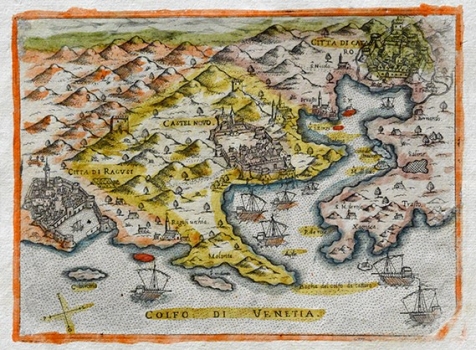CAMOCIO, GIOVANNI FRANCESCO: MAP VITH VIEWS OF DUBROVNIK, HERCEG NOVI AND KOTOR
Inventory number 425
Original title: Bez naslova / no title / Ohne Titel
Publishing year: 1571
Place of publishing and publisher: Venezia
Format: 15,5x21 cm
Technique: Coloured copper engraving
The views of Dubrovnik, Herceg Novi and Kotor with surroundings have been published in the famous isolario "Isole famose, porti, fortezze... ", which served as a model for many of the later Italian isolarii, all the time to Coronelli from the second half of the 17th century. The author is not known, but it is possible that it is Martin Rota Kolunić, who drew several views and maps for Camocio's isolario. The views are drawn very skillfully and, given the size of the drawings, they provide a lot of information about the appearance of the cities. The tower of the Franciscan monastery, the harbour and the arsenal, as well as the monastery of St. James (St. Jakov) outside the city wall are depicted on the view of Dubrovnik. It is interesting that the view is coloured, which is very rare. The same map with the views was published by Simone Pinargenti two years later in his isolario, but with his monogram in the lower right corner.
CAMOCIO, GIOVANNI FRANCESCO
CAMOCIO, GIOVANNI FRANCESCO (Camocius, Camotio, Cametti, Gioan, Joan Francisco) a Venetian cartographer, publisher and merchant whose most productive period was between 1558 and 1575. He obtained his bookseller's and publisher's licence in Venice in 1552, marked Al segno della Pyramide. His copper-plate engraving workshop produced maps and vedute that as a publisher he was signing with apresso or apud G. F. Camocio cum privilegio. The most fertile period of his artistic production, between the 1550s and the 1570s, was also the peak of the isolarii (depictions of islands) period, especially in Italy. These are detailed, practical, perspective depictions of certain cities and ports, created predominantly in a large-scale copper-plate engraving technique. Unlike earlier portulan charts, these depictions of the maritime area and the inland of the islands were largely based on field work. Along with G. Rosaccio, G. Franco and S. Pinargenti, Camocio was the most significant representative of the tradition. His interest lay on the eastern Adriatic coast where he had his informants and topographers, so he created several maps of the Croatian lands. His most famous works are Lombardija Atlantic from 1560, which he created with Forlani, Dalmatia i Friuli from 1563, Isole Famose from 1563 and 1564, Grčka, Italija i Napulj from 1566, Venecija from 1571 and Europa, published in 1579. His copper plates were passed on to Donato Bertelli. Copper plates were, at the time, passed on, inherited, exchanged and traded, and the information they carried was also often exchanged among cartographers and publishers. His most famous maps of our (Croatian) territories are Novo dissegno della Dalmatia et Crovatia from 1566, Istra from 1569, and he also authored the isolario or atlas Isole famose, porti, fortezze e terre maritimme… from 1571 and 1574, comprising a large number of maps of the Croatian territories, although he did not author all of the maps contained within it. Almost twenty of his maps are depictions of the Croatian Littoral or port vedute, but he only signed some of them, which are most likely the ones he personally refined or updated. His maps of Dalmatia and Istria show that he had access to higher quality topographic templates or data only for some regions, such as Coppo’s map of Istria from 1525. He also published the works by local cartographers, Natalo Bonifaci and Martino Rota, from where he clearly sourced the cartographic information for his own works. He was obviously very skilled in selecting the information he would use, as he tried to correct some frequently repeated errors he had come accross.


